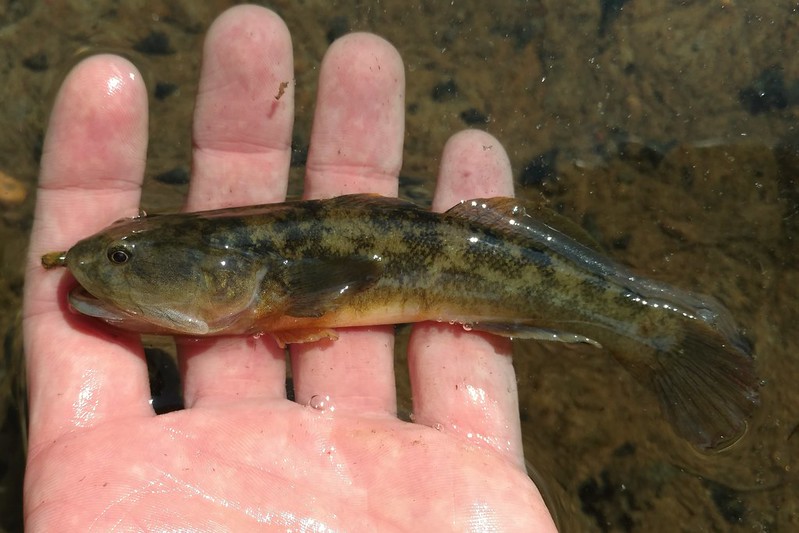Earlier this year one of my contacts at Scripps asked if I could help one of his graduate students collect longjaw mudsuckers for a research project. It just so happens I have a spot where I can reliably catch them, so I quickly agreed to help. If you're not familiar with longjaw mudsuckers, they're a goby species native to California, and they have a noticeably long jaw. They may or may not suck mud. In my opinion they should have just been named longjaw goby.
Longjaw Mudsucker (Gillichthys mirabilis)
I agreed to meet a couple people from Scripps after sundown, but there was a good low tide in the afternoon, so I drove down to Mission Bay a few hours early to pump ghost shrimp for bait. Big gobies usually aren't hard to catch, but I was feeling the pressure, so I wanted to have the best bait possible. While I was pumping shrimp I noticed a few extremely small gobies on the sand flats hanging around the ghost shrimp burrows.
Later that night I showed the photos to one of the Scripps researchers, and he identified the fish as a cheekspot goby. The dark spot on the operculum makes the ID pretty easy, but he did mention that there are multiple goby species that cohabitate with ghost shrimp. I'll have to try to catch one on hook & line at some point!
Cheekspot Goby (Ilypnus gilberti)
Around sunset I met Jimjohn, the grad student working on the project, at the mudsucker spot. We rigged up and began fishing. I told him the mudsuckers would be easy to find, but for the first hour or two all we could catch were the other species common at that location. My mudsucker catching reputation was in jeopardy!
Yellowfin Goby (Acanthogobius flavimanus)
California Killifish (Fundulus parvipinnis)
Once it was completely dark our luck improved. With headlamps on we were able to find mudsuckers sitting on the bottom near shore. Several more researchers from Scripps arrived, and everyone got to work looking for fish for us to catch.
Before long we had collected about a dozen mudsuckers as well as a few nonnative yellowfin gobies and native California killifish. Everything we caught went into a cooler with an aerator that would go back to Scripps.
What I originally thought would be a 2 or 3 person gathering ended up being 8 people, which certainly helped make the search for mudsuckers easier. In the photo below, from left to right, are Zach Skelton, H.J. Walker, Phil Hastings, Tor Mowatt-Larssen, Jimjohn Milan, Alma Javier, and Ben Frable.
Update:
In February 2020 I asked Jimjohn for an update on how his project is going. He sent some photos of the mudsuckers in their holding tanks and said they would be beginning the behavior study soon.
Here's two of the gobies being roommates. They don't seem to be on speaking terms with each other unfortunately. I hope they can work things out.
Here's a really big fella that is probably eating more than his fair share of the food (squid, according to Jimjohn). They certainly seem to be doing well in captivity.
The same big fella is in the photo below, and it's a good example of how well mudsuckers, and most benthic fish, can change their appearance to match their surroundings. Deactivate sand mode, activate gravel mode!
The behavior study Jimjohn will be doing has to do with whether or not adult mudsuckers use their modified jaws to gape at each other the way some other fish like fringeheads and rockskippers do. Hopefully he's able to get some good photos and videos of them showing the behavior!












No comments:
Post a Comment
Note: Only a member of this blog may post a comment.